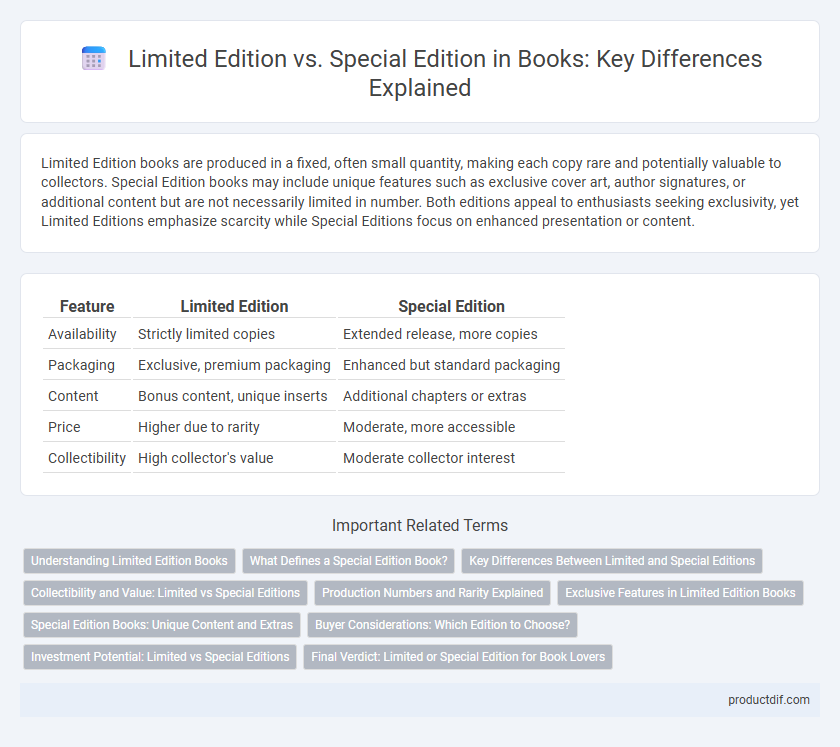Limited Edition books are produced in a fixed, often small quantity, making each copy rare and potentially valuable to collectors. Special Edition books may include unique features such as exclusive cover art, author signatures, or additional content but are not necessarily limited in number. Both editions appeal to enthusiasts seeking exclusivity, yet Limited Editions emphasize scarcity while Special Editions focus on enhanced presentation or content.
Table of Comparison
| Feature | Limited Edition | Special Edition |
|---|---|---|
| Availability | Strictly limited copies | Extended release, more copies |
| Packaging | Exclusive, premium packaging | Enhanced but standard packaging |
| Content | Bonus content, unique inserts | Additional chapters or extras |
| Price | Higher due to rarity | Moderate, more accessible |
| Collectibility | High collector's value | Moderate collector interest |
Understanding Limited Edition Books
Limited edition books are produced in a finite, predetermined quantity, often numbered and signed by the author to enhance their rarity and collectible value. These editions feature unique characteristics such as high-quality materials, special bindings, and exclusive content that distinguish them from regular prints. Collectors prioritize limited editions due to their scarcity and potential for increased market worth over time.
What Defines a Special Edition Book?
A Special Edition book is defined by unique features such as exclusive cover art, author signatures, or additional content not found in standard or limited editions. These editions often include enhanced packaging, extended illustrations, or supplementary essays that enrich the reading experience. Unlike Limited Editions, which are primarily distinguished by their restricted print runs, Special Editions emphasize collectible value through distinct aesthetic and content enhancements.
Key Differences Between Limited and Special Editions
Limited Edition books are produced in a fixed, often small quantity, enhancing their rarity and collectible value, often featuring numbered copies. Special Edition books usually encompass unique content such as bonus chapters, distinctive cover art, or added illustrations, focusing more on exclusive content than quantity. Collectors prioritize Limited Editions for scarcity, while readers seeking enhanced experience often prefer Special Editions.
Collectibility and Value: Limited vs Special Editions
Limited Edition books typically feature a restricted number of copies, often numbered and signed, which enhances their collectibility and potential value over time. Special Edition books may include unique content, artwork, or deluxe packaging but are not always limited in quantity, making them less rare compared to Limited Editions. Collectors prioritize Limited Editions for their scarcity and exclusivity, driving higher market demand and appreciation in value.
Production Numbers and Rarity Explained
Limited Edition books are produced in a strictly defined number, often ranging from a few hundred to a few thousand copies, enhancing their rarity and collectibility. Special Edition books may have larger print runs but are distinguished by unique features such as exclusive cover art, signed copies, or additional content. The explicit limitation of production numbers in Limited Editions significantly increases their scarcity compared to Special Editions, making them more valuable to collectors.
Exclusive Features in Limited Edition Books
Limited Edition books often include exclusive features such as numbered copies, author signatures, and unique cover designs that are not available in Special Editions. These elements enhance collectibility and value, making Limited Editions highly sought after by bibliophiles and collectors. Special Editions may offer bonus content or enhanced packaging but typically lack the exclusivity and restricted quantity that define Limited Editions.
Special Edition Books: Unique Content and Extras
Special Edition books often feature exclusive content such as author interviews, additional chapters, or illustrated artwork that sets them apart from standard prints. These editions typically include high-quality materials, like embossed covers or premium paper, enhancing their collectible value. Collectors and readers seek Special Editions for their unique extras that provide a richer, more immersive reading experience.
Buyer Considerations: Which Edition to Choose?
Buyers should evaluate Limited Editions for their rarity and potential investment value, often characterized by a fixed print run and unique features such as numbered copies or exclusive artwork. Special Editions appeal to collectors seeking enhanced content, including bonus chapters, author annotations, or deluxe packaging, without the stringent scarcity of Limited Editions. Understanding personal priorities--whether exclusivity or enriched reading experience--guides the decision between Limited Edition and Special Edition books.
Investment Potential: Limited vs Special Editions
Limited edition books typically have a fixed, low print run, enhancing scarcity and often increasing their long-term investment potential. Special editions may include additional content or unique features but usually have larger print runs, making them less rare and potentially less valuable. Collectors and investors prioritize limited editions for their exclusivity and higher likelihood of appreciating value in the rare book market.
Final Verdict: Limited or Special Edition for Book Lovers
Limited editions are typically produced in smaller quantities, offering exclusive features such as unique artwork or signed copies that enhance their collectible value for book enthusiasts. Special editions may include bonus content, revised text, or superior binding but are often more widely available, appealing to readers seeking enriched reading experiences. For book lovers prioritizing rarity and investment potential, limited editions hold greater allure, whereas those desiring additional content and aesthetic upgrades may prefer special editions.
Limited Edition vs Special Edition Infographic

 productdif.com
productdif.com